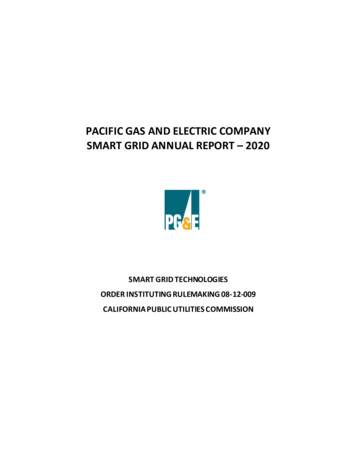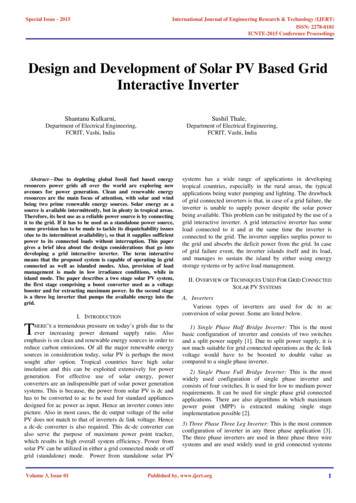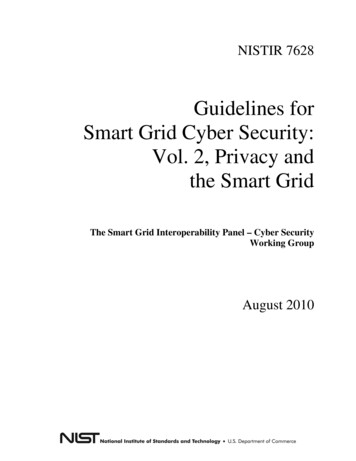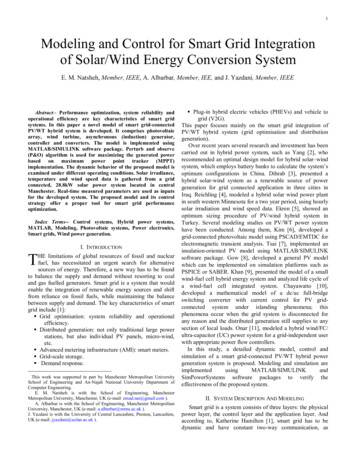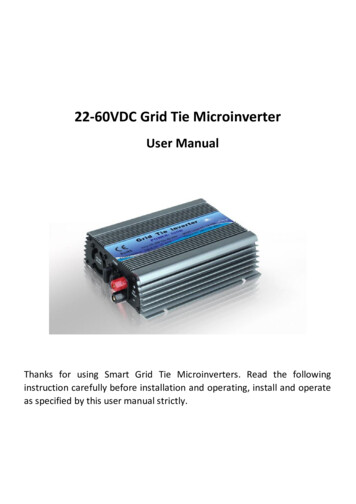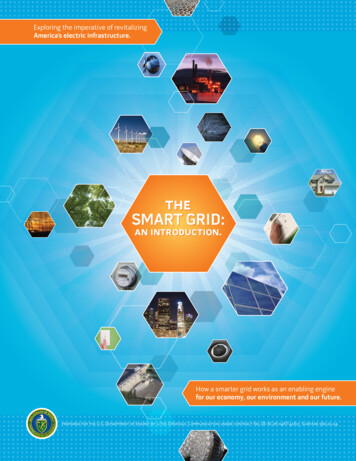
Transcription
Exploring the imperative of revitalizingAmerica’s electric infrastructure.theSMART GRID:an introduction.How a smarter grid works as an enabling enginefor our economy, our environment and our future.prepared for the U.S. Department of Energy by Litos Strategic Communication under contract No. DE-AC26-04NT41817, Subtask 560.01.04
DISCLAIMERThis report was prepared as an account of work sponsored by an agency of the United States Government. Neither the United States Governmentnor any agency thereof, nor Litos Strategic Communication, nor any of their employees, make any warranty, express or implied, or assumes anylegal liability or responsibility for the accuracy, completeness, or usefulness of any information apparatus, product, or process disclosed, orrepresents that its use would not infringe privately owned rights. Reference herein to any specific commercial product, process, or service by tradename, trademark, manufacturer or otherwise does not necessarily constitute or imply its endorsement, recommendation or favoring by theUnited States Government or any agency thereof, or Litos Strategic Communication. The views and opinions of authors expressed herein do notnecessarily state or reflect those of the United States Government or any agency thereof.PRINTED IN THE UNITED STATES OF AMERICA.
PREFACEIt is a colossal task. But it is a taskthat must be done.The Department of Energy has been charged with orchestrating the wholesalemodernization of our nation’s electrical grid.While it is running.Full-tilt.Heading this effort is the Office of Electricity Delivery and Energy Reliability. Inconcert with its cutting edge research and energy policy programs, the office’s newlyformed, multi-agency Smart Grid Task Force is responsible for coordinating standardsdevelopment, guiding research and development projects, and reconciling the agendasof a wide range of stakeholders.Equally critical to the success of this effort is the education of all interested membersof the public as to the nature, challenges and opportunities surrounding the SmartGrid and its implementation.It is to this mission that The Smart Grid: An Introduction is dedicated.From the Department of EnergyThe Smart Grid Introduction is intended primarily toacquaint non-technical yet interested readers about: the existence of, and benefits accruingfrom, a smarter electrical grid what the application of such intelligencemeans for our country how DOE is involved in helping to accelerateits implementation.
TOCKNOWLEDGE BROUGHTTO POWER
FOUND ONSECTIONONE Introduction: We Don’t Have Much Time.2Toward an orderly transition to a smarter grid TWO Edison vs. Graham Bell: The Case for Revitalization.4Presenting the argument in a timely fashion requires a trip “back to the future ”THREE The Grid as It Stands: What’s at Risk?6The many hazards associated with operating the 20th century grid in the 21st century.The lights may be on, but consider what we’re missing 10FOUR The Smart Grid: What It Is. What It Isn’t.Why it’s important to know the difference FIVE Compare and Contrast: A Grid Where Everything is Possible.For an invigorating vision of our energy future, look forward 16TOPICSSIX First Things First: Teasing Out the Complexities.24How various constituencies – i.e., utilities and regulators – are working towardfundamental realignment to make a smarter grid get here faster SEVEN How Things Work: Creating the Platform for the Smart Grid.28Making it possible for consumers to participate EIGHT Progress Now!: A Look at Current Smart Grid Efforts and How They’re Succeeding.32From West Virginia to California to Hawaii, a smarter grid is taking shape NINE Edison Unbound: What’s Your Stake in All This?36Benefits for everyone Resources and Glossary40Coming to terms with the Smart Grid.1
Section One :IntroductionWe don’t have much time.Our nation’s electric power infrastructure that has served us so well for so long – also known as “the grid” –is rapidly running up against its limitations. Our lights may be on, but systemically, the risks associated withrelying on an often overtaxed grid grow in size, scale and complexity every day. From national challenges likepower system security to those global in nature such as climate change, our near-term agenda is formidable.Some might even say history-making.Fortunately, we have a way forward.There is growing agreement among federal and state policymakers, businessleaders, and other key stakeholders, around the idea that a Smart Grid is not onlyneeded but well within reach. Think of the Smart Grid as the internet brought toour electric system.A tale of two timelinesThere are in fact two grids to keep in mind as our future rapidly becomes the present.The first – we’ll call it “a smarter grid” – offers valuable technologies that can be deployed within the very near futureor are already deployed today.The second – the Smart Grid of our title – represents the longer-term promise of a grid remarkable in its intelligenceand impressive in its scope, although it is universally considered to be a decade or more from realization. Yet given howa single “killer application” – e-mail – incited broad, deep and immediate acceptance of the internet, who is to say thata similar killer app in this space won’t substantially accelerate that timetable?In the short term, a smarter grid will function more efficiently, enabling it to deliver the level of service we’ve come toexpect more affordably in an era of rising costs, while also offering considerable societal benefits – such as less impacton our environment.Longer term, expect the Smart Grid to spur the kind of transformation that the internet has already brought to theway we live, work, play and learn.2
A smarter grid applies technologies, tools and techniques available now to bring knowledge to power –knowledge capable of making the grid work far more efficiently. Ensuring its reliability to degrees never before possible. Maintaining its affordability. Reinforcing our global competitiveness. Fully accommodating renewable and traditional energy sources. Potentially reducing our carbon footprint. Introducing advancements and efficiencies yet to be envisioned.Transforming our nation’s grid has been compared in significance with building the interstate highway systemor the development of the internet. These efforts, rightly regarded as revolutionary, were preceded by countlessevolutionary steps. Envisioned in the 1950s, the Eisenhower Highway System was not completed until the early1980s. Similarly, the internet’s lineage can be directly traced to the Advanced Research Projects Agency Network(ARPANET) of the U.S. Department of Defense in the 60s and 70s, long before its appearance as a society-changingtechnology in the 80s and 90s.In much the same way, full implementation of the Smart Grid will evolve over time. However, countless positivesteps are being taken today, organizations energized and achievements realized toward reaching that goal. Youwill learn about some of them here.The purpose of this book is to give readers – in plain language – a fix on the current position of the Smart Grid andits adoption. You will learn what the Smart Grid is – and what it is not. You will get a feel for the issues surroundingit, the challenges ahead, the countless opportunities it presents and the benefits we all stand to gain.Remember life before e-mail?With every passing day, fewer and fewer people do.With the appropriate application of ingenious ideas, advanced technology, entrepreneurial energy and political will,there will also come a time when you won’t remember life before the Smart Grid.3
Menlo Park WorkshopPearl Street StationFirst Street LampsMeteringCompact Fluorescent Lightadvancements in electricityThere is a popular comparison thatunderscores the pace of change – or lackthereof – regarding our nation’s grid.Section TWO:Edison vs.GRAHAM Bell:The case forREVITALIZATION.The story goes like this:If Alexander Graham Bell were somehow transportedto the 21st century, he would not begin to recognizethe components of modern telephony – cell phones,texting, cell towers, PDAs, etc. – while Thomas Edison,one of the grid’s key early architects, would be totallyfamiliar with the grid.advancements in telecommunications4First TelephoneOperator Switching StationsRotary DialingNorth AmericanNumbering SystemRotary Dial with Ringerand Handset
While this thought experiment speaks volumes aboutGiven that the growth of the nation’s global economic leadershipappearances, it is far from the whole story. Edison would be quiteover the past century has in many ways mirrored the trajectoryfamiliar with the grid’s basic infrastructure and perhaps even anof the grid’s development, this choice is not surprising.electromechanical connection or two, but he would be just asdazzled as Graham Bell with the technology behind the scenes.In many ways, the present grid works exceptionally well forwhat it was designed to do – for example, keeping costs down.Our century-old power grid is the largest interconnectedBecause electricity has to be used the moment it is generated,machine on Earth, so massively complex and inextricably linkedthe grid represents the ultimate in just-in-time product delivery.to human involvement and endeavor that it has alternately (andEverything must work almost perfectly at all times – and does.appropriately) been called an ecosystem. It consists of moreWhenever an outage occurs in, say, Florida, there may well bethan 9,200 electric generating units with more than 1,000,000repercussions up the Atlantic seaboard; however, due to themegawatts of generating capacity connected to more thansystem’s robustness and resultant reliability, very few outside300,000 miles of transmission lines.the industry ever know about it.POWER SYSTEM FACTToday’s electricity system is 99.97percent reliable, yet still allows forpower outages and interruptions that costAmericans at least 150 billion eachyear — about 500 for every man,woman and child.In celebrating the beginning of the 21st century, the NationalEngineered and operated by dedicated professionals overAcademy of Engineering set about identifying the single mostdecades, the grid remains our national engine. It continues toimportant engineering achievement of the 20th century. Theoffer us among the highest levels of reliability in the world forAcademy compiled an estimable list of twenty accomplishmentselectric power. Its importance to our economy, our nationalwhich have affected virtually everyone in the developed world.security, and to the lives of the hundreds of millions it servesThe internet took thirteenth place on this list, and “highways”cannot be overstated.eleventh. Sitting at the top of the list was electrification asmade possible by the grid, “the most significant engineeringBut we – all of us – have taken this marvelous machine forgranted for far too long. As a result, our overburdened gridachievement of the 20th Century.”has begun to fail us more frequently and presents us withsubstantial risks.Long Distance CallingFirst Telecom SatelliteTouch-Tone TelephonesCellular CommunicationsPhone Over the Internet5
Since 1982, growth in peak demand for electricity –driven by population growth, bigger houses, biggerTVs, more air conditioners and more computers– has exceeded transmission growth by almost25% every year. Yet spending on research anddevelopment – the first step toward innovationand renewal – is among the lowest of all industries.Section THREE:The Grid as ItStands: WHAT’SAT RISK?R&D as a % of RevenueEven as demand has skyrocketed, there has beenchronic underinvestment in getting energy where itElectricUtilitiesneeds to go through transmission and distribution,Agriculturefurther limiting grid efficiency and reliability. WhilePrintinghundreds of thousands of high-voltage transmissionlines course throughout the United States, only 668additional miles of interstate transmission have beenbuilt since 2000. As a result, system constraintsworsen at a time when outages and power qualityLess than 2%Stone,Clay & GlassRetailAircraft &MissilesDurable GoodsHealthcareissues are estimated to cost American business moreOffice Mechthan 100 billion on average each year.Energy &ManagmentServices0%In short, the grid is struggling to keep up.64%8%PERCENTAGE of REVENUE12%
Based on 20TH century design requirements and having maturedRELIABILITY: There have been five massive blackouts overin an era when expanding the grid was the only option andthe past 40 years, three of which have occurred in the pastvisibility within the system was limited, the grid has historicallynine years. More blackouts and brownouts are occurringhad a single mission, i.e., keeping the lights on. As for otherdue to the slow response times of mechanical switches, amodern concerns lack of automated analytics, and “poor visibility” – a “lack ofsituational awareness” on the part of grid operators. This issueEnergy efficiency? A marginal consideration at best whenenergy was – as the saying went – “too cheap to meter.”of blackouts has far broader implications than simply waitingfor the lights to come on. Imagine plant production stopped,Environmental impacts? Simply not a primary concern whenperishable food spoiling, traffic lights dark, and credit cardthe existing grid was designed.transactions rendered inoperable. Such are the effects of evena short regional blackout.Customer choice? What was that?did you knowIn many areas of the United States, theonly way a utility knows there’s an outageis when a customer calls to report it.Today, the irony is profound: In a society where technologyreigns supreme, America is relying on a centrally planned andcontrolled infrastructure created largely before the age ofmicroprocessors that limits our flexibility and puts us at riskon several critical fronts:POWER SYSTEM FACT41% more outages affected 50,000or more consumers in the second half ofEFFICIENCY: If the grid were just 5% more efficient, the energythe 1990s than in the first half of the decade.savings would equate to permanently eliminating the fuel andThe “average” outage affected 15 percentgreenhouse gas emissions from 53 million cars. Consider this,more consumers from 1996 to 2000too: If every American household replaced just one incandescentthan from 1991 to 1995 (409,854bulb (Edison’s pride and joy) with a compact fluorescent bulb, theversus 355,204).country would conserve enough energy to light 3 million homesand save more than 600 million annually. Clearly, there areterrific opportunities for improvement.7
Section three : ContinuedThe grid as it stands: What’s at risk?NATIONAL ECONOMY: The numbers are staggering and speakfor themselves: A rolling blackout across Silicon Valley totaled 75resource recoverymillion in losses.Dollars that remain in the In 2000, the one-hour outage that hit the Chicagoeconomy rather than “paying theBoard of Trade resulted in 20 trillion in trades delayed.freight” for system inefficiency Sun Microsystems estimates that a blackout costsare dollars that society can putthe company 1 million every minute.to good use for job creation,healthcare, and homeland security. The Northeast blackout of 2003 resulted in a 6billion economic loss to the region.Compounding the problem is an economy relentlessly grown digital. Inthe 1980s, electrical load from sensitive electronic equipment, such aschips (computerized systems, appliances and equipment) and automatedmanufacturing was limited. In the 1990s, chip share grew to roughly 10%.Today, load from chip technologies and automated manufacturing has risento 40%, and the load is expected to increase to more than 60% by 2015.AFFORDABILITY: As rate caps come off in state after state, the cost ofelectricity has doubled or more in real terms. Less visible but just as harmful,the costs associated with an underperforming grid are borne by every citizen,yet these hundreds of billions of dollars are buried in the economy and largelyunreported. Rising fuel costs – made more acute by utilities’ expiring longterm coal contracts – are certain to raise their visibility.Decrease in Transmission Investment (Dollar Amount In Billions) 6- 117 million 5 4 3 2 1‘ 758’80‘85’90Y E AR S‘95’00
SECURITY: When the blackout of 2003 occurred – the largest in US history –those citizens not startled by being stuck in darkened, suffocating elevatorsturned their thoughts toward terrorism. And not without cause. The grid’scentralized structure leaves us open to attack. In fact, the interdependenciesof various grid components can bring about a domino effect – a cascading seriesof failures that could bring our nation’s banking, communications, traffic, andU.S. Share of World PopulationCompared to its Production ofGreenhouse Gasessecurity systems among others to a complete standstill.ENVIRONMENT/CLIMATE CHANGE: From food safety to personal health, acompromised environment threatens us all. The United States accounts for only4% of the world’s population and produces 25% of its greenhouse gases. Half of4%our country’s electricity is still produced by burning coal, a rich domestic resourcebut a major contributor to global warming. If we are to reduce our carbon footprintand stake a claim to global environmental leadership, clean, renewable sources ofenergy like solar, wind and geothermal must be integrated into the nation’s grid.The U.S. accounts for 4% of theworld’s population while contributing25% of its greenhouse gases.However, without appropriate enabling technologies linking them to the grid,their potential will not be fully realized.GLOBAL COMPETITIVENESS: Germany is leading the world in the developmentand implementation of photo-voltaic solar power. Japan has similarly moved tothe forefront of distribution automation through its use of advanced battery-25%storage technology. The European Union has an even more aggressive “SmartGrids” agenda, a major component of which has buildings functioning as powerplants. Generally, however, these countries don’t have a “legacy system” on theorder of the grid to consider or grapple with.How will a smarter grid address these risks and others? Read on.DENMARK’s PROGRESS OVER THE PAST TWO DECADESSmall CHP (Combined Heat & Power)Large CHP (Combined Heat & Power)WindCentralized System of the mid 1980’sMore Decentralized System of Today9
Prepare for an electric system that iscleaner and more efficient, reliable,resilient and responsive –a smarter grid.Section FOUR :The Smart Grid:What It Is.What It Isn’t.part 1: what it is.The electric industry is poised to make the transformationfrom a centralized, producer-controlled network to one thatis less centralized and more consumer-interactive. The moveto a smarter grid promises to change the industry’s entirebusiness model and its relationship with all stakeholders,involving and affecting utilities, regulators, energy serviceproviders, technology and automation vendors and allconsumers of electric power.10
A smarter grid makes this transformation possible by bringingBecause this interaction occurs largely “in the background,” withthe philosophies, concepts and technologies that enabled theminimal human intervention, there’s a dramatic savings on energyinternet to the utility and the electric grid. More importantly,that would otherwise be consumed.it enables the industry’s best ideas for grid modernization toThis type of program has been tried in the past, but without Smartachieve their full potential.Grid tools such as enabling technologies, interoperability basedConcepts in action.on standards, and low-cost communication and electronics, itIt may surprise you to know that many of these ideas are alreadypossessed none of the potential that it does today.in operation. Yet it is only when they are empowered by means ofthe two-way digital communication and plug-and-play capabilitiesthat exemplify a smarter grid that genuine breakthroughs beginto multiply.Visualization technology. Consider grid visualization and thetools associated with it. Already used for real-time load monitoringand load-growth planning at the utility level, such tools generallylack the ability to integrate information from a variety of sourcesor display different views to different users. The result: LimitedPOWER SYSTEM FACTAVERAGE COST FOR 1 HOUR OFPOWER INTERRUPTIONINDUSTRYCellular communicationsTelephone ticket salesAirline reservation systemSemiconductor manufacturerCredit card operationBrokerage operationAMOUNT 41,000 72,000 90,000 2,000,000 2,580,000 6,480,000Advanced Metering Infrastructure (AMI) is an approach tosituational awareness. This condition will grow even more acuteintegrating consumers based upon the development of openas customer-focused efficiency and demand-response programsstandards. It provides consumers with the ability to use electricityincrease, requiring significantly more data as well as the abilitymore efficiently and provides utilities with the ability to detectto understand and act on that data.problems on their systems and operate them more efficiently.Next-generation visualization is on its way. Of particular note isAMI enables consumer-friendly efficiency concepts like “Prices toVERDE, a project in development for DOE at the Oak Ridge NationalDevices” to work like this: Assuming that energy is priced on whatLaboratory. VERDE (Visualizing Energy Resources Dynamically onit costs in near real-time – a Smart Grid imperative – price signalsEarth) will provide wide-area grid awareness, integrating real-are relayed to “smart” home controllers or end-consumer devicestime sensor data, weather information and grid modeling withlike thermostats, washer/dryers and refrigerators – the home’sgeographical information. Potentially, it will be able to explore themajor energy-users. The devices, in turn, process the informationstate of the grid at the national level and switch within secondsbased on consumers’ learned wishes and power accordingly. Theto explore specific details at the street level. It will provide rapidhouse or office responds to the occupants, rather than vice-versa.information about blackouts and power quality as well as insightsinto system operation for utilities. With a platform built on GoogleEarth, it can also take advantage of content generated by GoogleEarth’s user community.11
Section FOUR : Continuedthe smart grid: What it is. what it isn’t.Just who’s running the grid?Formed at the recommendation of the FederalPhasor Measurement Units.Energy Regulatory Commission (FERC), anPopularly referred to as the power system’s “health meter,” PhasorIndependent System Operator (ISO) or RegionalMeasurement Units (PMU) sample voltage and current many timesTransmission Organization (RTO) is a profit-a second at a given location, providing an “MRI” of the power systemcompared to the “X-Ray” quality available from earlier Supervisory Controland Data Acquisition (SCADA) technology. Offering wide-area situationalawareness, phasors work to ease congestion and bottlenecks and mitigateneutral organization in charge of reconcilingsupply and demand as it coordinates, controlsand monitors the operation of the powersystem. The ISO’s control area can encompass– or even prevent – blackouts.one state or several.Typically, measurements are taken once every 2 or 4 seconds offering asteady state view into the power system behavior. Equipped with SmartThe role of these organizations is significantGrid communications technologies, measurements taken are preciselyin making the Smart Grid real. ISOs and RTOstime-synchronized and taken many times a second (i.e., 30 samples/second)will use the smart distribution system asoffering dynamic visibility into the power system.another resource for managing a secure andAdoption of the Smart Grid will enhance every facet of the electric deliverymost economic transmission system. “Lessonssystem, including generation, transmission, distribution and consumption.learned” from their experiences in buildingIt will energize those utility initiatives that encourage consumers to modifyprocesses and technologies, etc., will be directlypatterns of electricity usage, including the timing and level of electricitydemand. It will increase the possibilities of distributed generation, bringingapplicable to efforts in grid transformation,both short-term and long-term.generation closer to those it serves (think: solar panels on your roof ratherthan some distant power station). The shorter the distance from generationto consumption, the more efficient, economical and “green” it may be. It willempower consumers to become active participants in their energy choicesto a degree never before possible. And it will offer a two-way visibility andcontrol of energy usage.smart definition: distributed generationDistributed generation is the use of small-scale power generation technologieslocated close to the load being served, capable of lowering costs, improvingreliability, reducing emissions and expanding energy options.12
An automated, widely distributed energy delivery network, theSmart Grid will be characterized by a two-way flow of electricityand information and will be capable of monitoring everything frompower plants to customer preferences to individual appliances.It incorporates into the grid the benefits of distributed computingDemand Profileand communications to deliver real-time information and enablethe near-instantaneous balance of supply and demand at the320device level.The problem with peak.240While supply and demand is a bedrock concept in virtually allmightily because, as noted, electricity must be consumed themoment it’s generated.KILOWATTSother industries, it is one with which the current grid struggles160Without being able to ascertain demand precisely, at a given time,having the ‘right’ supply available to deal with every contingency80is problematic at best. This is particularly true during episodes ofpeak demand, those times of greatest need for electricity duringa particular period.006121824HOURS of the DAY13
Section FOUR : ContinuedThe grid today: What it is. What it isn’t.Imagine that it is a blisteringly hot summer afternoon. With countless commercialand residential air conditioners cycling up to maximum, demand for electricity is beingdriven substantially higher, to its “peak.” Without a greater ability to anticipate, withoutknowing precisely when demand will peak or how high it will go, grid operators andutilities must bring generation assets called peaker plants online to ensure reliability andmeet peak demand. Sometimes older and always difficult to site, peakers are expensiveto operate – requiring fuel bought on the more volatile “spot” market. But old or not,additional peakers generate additional greenhouse gases, degrading the region’s airquality. Compounding the inefficiency of this scenario is the fact that peaker plants aregeneration assets that typically sit idle for most of the year without generating revenuebut must be paid for nevertheless.In making real-time grid response a reality, a smarter grid makes it possible to reduce thehigh cost of meeting peak demand. It gives grid operators far greater visibility into thesystem at a finer “granularity,” enabling them to control loads in a way that minimizesthe need for traditional peak capacity. In addition to driving down costs, it may eveneliminate the need to use existing peaker plants or build new ones – to save everyonemoney and give our planet a breather.part 2: what thesmart grid isn’t.People are often confused by the terms Smart Grid and smart meters. Are they not thesame thing? Not exactly. Metering is just one of hundreds of possible applications thatconstitute the Smart Grid; a smart meter is a good example of an enabling technologythat makes it possible to extract value from two-way communication in support ofdistributed technologies and consumer participation.As much as “smarttechnologies” can enhance thisfamiliar device, it’s not the samething as the Smart Grid.14
As one industry expert explains it, there is no silver bullet when it comes toenabling technologies for a smarter grid; there is instead “silver buckshot,”an array of technological approaches that will make it work.Further clarification: Devices such as wind turbines, plug-in hybrid electricvehicles and solar arrays are not part of the Smart Grid. Rather, the SmartGrid encompasses the technology that enables us to integrate, interfacewith and intelligently control these innovations and others.The ultimate success of the Smart Grid depends on the effectiveness ofthese devices in attracting and motivating large numbers of consumers.illustrating the opportunities: the smart grid as enabling engine.Enabling nationwide use ofplug-in hybrid electric vehicles Making large-scale energystorage a reality Making use of solar energy –24 hours a day Allowing the seamless integration ofrenewable energy sources like wind SMARTGRIDUshering in a new era ofconsumer choice Exploiting the use of green buildingstandards to help “lighten the load.”15
The Smart Grid transforms the current gridto one that functions more cooperatively,responsively and organically.Section FIVE:Compare andContrast:A Grid WhereEverythingis Possible.SMART GRID FACTMade possible by a smarter grid, DOE’sSolar Energy Grid Integration Systems(SEGIS) is a suite of tools, techniques andtechnologies designed to achieve ahigh penetration of photovoltaic(PV) systems into homesand businesses.16
Intelligent – capable of sensing system overloads andIN TERMS OFOVERALL VISION,The Smart Grid is:rerouting power to prevent or minimize a potential outage;of working autonomously when conditions require resolutionfaster than humans can respond and cooperatively in aligningthe goals of utilities, consumers and regulatorsEfficient – capable of meeting increased consumer demand withoutadding infrastructureAccommodating – accepting en
The purpose of this book is to give readers – in plain language – a fix on the current position of the Smart Grid and its adoption. You will learn what the Smart Grid is – and what it is not. You will get a feel for the issues surrounding it, the challenges ahead, the countless opportu


